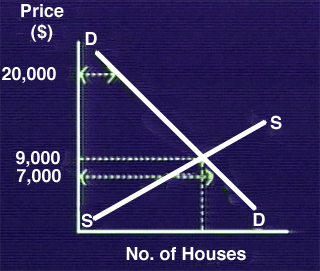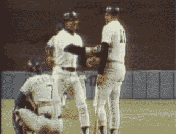ECONOMICS U$A
MARKETS AND PRICES
To show how a well-functioning free market pricing system determines how producers manufacture goods, what goods will be manufactured, and for whom the goods will be produced.
OBJECTIVES:
1. The meeting of buyers and sellers in a market can be represented by supply and demand curves. The curves show what sellers (buyers) are willing to sell (buy) at various prices. In a perfectly operating market the intersection of the supply and demand curves will be the point at which buyers and sellers agree on the price and quantity.
2. Goods are produced by using resources such as labor, machinery, and materials. The prices of these resources are set by supply and demand in the free market, and the producer is forced by competitive pressures to choose the method of production, which is least costly, i.e. the method which conserves high priced materials.
3. Consumers "reveal" how much they want a good by the way they spend their money. If a great deal of money is being spent on a certain good, producers will try to make more of that good. If consumers change the way they spend their money, producers will respond.
4. There is a difference between "need" and "effective demand." The market system only responds to those who have money to spend. The poor have the need for many goods that the free market system will not provide for them, because the market system only responds to needs that people spend money on..
KEY ECONOMIC CONCEPTS:
supply and demand curves methods of production
shift in demand, market failure, equilibrium price and quantity.


|
Contemporary Issues
From time to time, we hear that (alternately) there are too many lawyers and too few doctors. What could create such an excess supply or excess demand? What kind of role might the American Bar Association and the American Medical Association be playing in such market disequilibria (mismatch between supply and demand)? What would happen if the markets for doctors and lawyers were perfectly competitive? |
For a complete transcript of this video program download TVpdf#2



|
WWII: Homes Sweet Homes Homebuilder William Levitt, the Henry Ford of the housing market, recognized the housing shortage and put money into building low cost housing. He laid out 6,000 lots on low cost, Long Island potato fields. He used assembly line methods to mass produce houses which would look very much the same. However, in a nation dedicated to individualism, would mass production houses have mass appeal? The answer was a resounding yes. People were coming out from all over the country to get a home. Regardless of what the place looked like, it filled their needs for housing. Levittown type developments sprang up in every major city and it paid off financially but also had a great psychological payoff by giving families a stake in their community and their country. |
|
American Mini -Steel Kenneth Iverson, President of NUCOR, wondered if low cost steel couldn’t be made in America. He decided it could by using Europe’s latest technology effectively lowering production costs. But what about labor costs? Lower prices of foreign steel makers were based on lower wages. However according to Iverson, "it’s not what you pay an employee that’s important. It’s what he produces." He was able to get his mini mill workers to produce at least 2 times that of the average integrated steel producer worker. This caused NACOR and other mini mills to become very efficient and profitable. The lesson for the integrated steel mills is that they can compete if they seek new ways of doing business. |
|
Take Me Out to the Ballgame So when hiring an employee means higher profits, most employers can see the higher salary as a good investment. In terms of the labor market, it helps to explain why there is a vast difference between the incomes of different people, even when they're on the same team. An underlying lesson is that the market doesn’t always produce a result we find personally agreeable, hence a talented athlete can earn more than the President of the United States. |